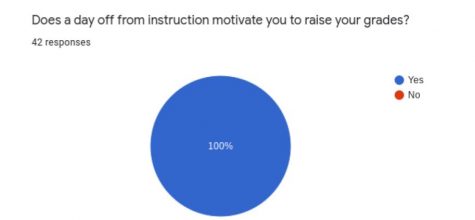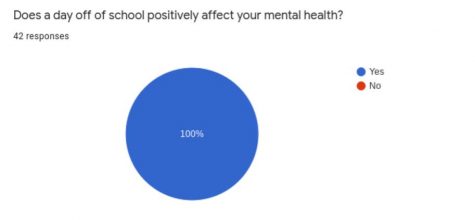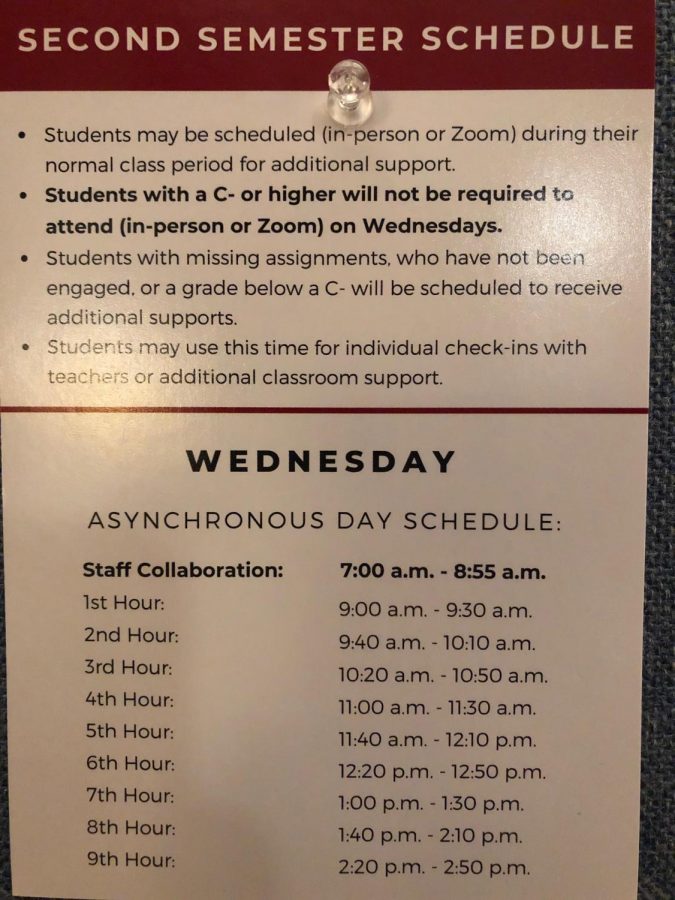Students in sync on keeping asynchronous Wednesdays
How is our student body adjusting to the new hybrid and remote learning structure? It has been a little over seven weeks since students have been coming back to school up to twice a week, and there is already talk of what’s working, and what’s not.
The new structure splits the alphabet into two groups, red group (A-K) and blue group (L-Z). Each group comes into school two days per week, and Wednesdays are strictly asynchronous. The only students who attend school through Zoom meetings on Wednesdays are those with a C- or below in a class, or who have been specifically instructed to do so by a teacher.
Now that District 155 has established a more consistent schedule, I wanted to find out how students are feeling about our new reality and the changes that come with it, such as the asynchronous Wednesday included in our schedule. Has it proved to be helpful, or is it unnecessary?
With the help of statistical research conducted by Cary-Grove seniors Ari R, Jason S, and Paige S, along with interviews of various underclassmen, we can get some insight on how students are adapting to the new learning structure. The new structure has many students feeling many different ways.
“I personally like the new structure and I think it’s way better than having to go to school on all five days of the week,” freshman Quinn J said. Students like freshman Vicky Nowak are in agreement with incorporating some or all of our current schedule into our future learning structure.
“I think that this new structure should be long-term,” Nowak said. “I encourage students to participate in hybrid learning if they are able to. The schedule with Wednesday being asynchronous is perfect and I think that now that we’re all used to it, we like it and don’t want it to change.”
I agree that there are some aspects of our current learning structure that could be included into future school schedules, but I definitely prefer physically being at school than learning from home.
“Hybrid isn’t a set-in-stone schedule and is quite confusing sometimes, but I still believe that it is better than being fully remote,” Quinn K said.
Staying at home doesn’t feel right, and it never has. It is merely a temporary solution and I don’t think many students, myself included, would ever want it to become permanent, but what if we were to integrate certain parts of our current structure into future learning models? What would we keep, and what would we get rid of?
“I would want classes to start at 8 a.m, because it allows students to get an extra hour or two of sleep, and I think it’s really beneficial for growth,” freshman Hadi Salim said.
Most student’s brains are not fully awake and ready to learn at 7:30 a.m, so having their classes start half an hour later would give them the necessary time to prepare.
“I like the current schedule alot, because in my opinion, I like how we start later in the day along with the ten minute passing periods between lunch,” Mia M said.
Having that extra time between lunch is helpful when kids are at school, because they can take their time to get their lunch and maybe stop to see friends on the way. It’s especially beneficial for students at home, because they get that extra time to finish up assignments, or relax and take their eyes off their screens for an hour.
“I would want to get rid of Zoom, because there is no separation from home and school. That separation is much needed,” freshman Quinn K said.
It’s always healthy to have boundaries between your personal life and your studious life, just like it’s important for adults to separate work from home. Zooming from our bedrooms eliminates those much-needed boundaries. Students are finding it challenging to relax in their rooms when it’s the same place that they do school.
Even though it matters to keep our school and home lives separated, I am not fully confident that we could function without having classes through Zoom. After wrapping up school in a disastrous fashion last summer, it’s quite clear that we can not rely on our students to lead their own learning.
“I would like to keep [the current structure] the way it is because changing things will throw [students, teachers, and parents] off, and it’s already been changed so much,” Nowak said. “I think we need a steady schedule. The schedule we have now, with the hybrid students and full remote, as well as the asynchronous Wednesday, is perfect. I think it gives us enough time with our teachers, and time for us to be independent as well.”
It’s a lot easier for students to focus on our learning when we have a solid schedule. The changes in the structure and our classes confused us, and made it hard to know what class to attend and when. This new schedule has been working out pretty well so far, so I see no reason to make drastic changes to our schedules anymore.
When it came to suggesting improvements that could be implemented to our structure, most students had nothing to say.
“I wouldn’t get rid of anything. This is the best we can do right now,” Salim said.
I think many students are currently content with how the new structure is working. There isn’t much of a want or need to change it.
Mia M is another student who is happy with our current structure.
“There isn’t anything I really dislike. I am content with the way our learning structure is.”
It’s definitely motivating to know that a lot of students appreciate the changes that District 155 has made to our structure. The biggest improvement that they have made thus far, is the asynchronous Wednesday.
I wanted to know if it has proved to be useful, and if it was necessary to add it in the first place. From personal experience, having a day free of Zoom meetings has given me the opportunity to catch up on assignments and to prepare for upcoming tests/projects.
“[Asynchronous Wednesday] motivates me to not go into school, therefore I focus on my work. It also allows for me to decompress and take a much needed break from Zoom,” Quinn K said.
Students are definitely taking advantage of having a “day off” from class to get caught up on missing assignments, and to get ahead. This Zoom-free day allows students to unwind a little and not feel overwhelmed or pressured by creeping due dates.
Some students, however, appreciate having the day off of Zoom, but don’t feel that it was imperative to implement it.
“I don’t think that it is necessary, but I like it,” freshman Quinn J said.
There are a lot of kids who don’t need the day off of classes to get extra help or to catch up on missing work, but it’s not like they would refuse to get a break from Zoom.
Out of the 42 students surveyed, 97.6% of them felt that including the asynchronous Wednesday was an appropriate measure to prevent Zoom fatigue.
It seems that a majority of students are happy with the asynchronous Wednesday, but is it truly motivating them to be productive and raise their grades?
“I would say that I am more motivated, because the asynchronous day gives me the opportunity to have a 1:1 talk with my teachers for help,” Nowak said. “It also serves as a good mental health day. It gives us students a break from all of the routine stuff, but we still have our work to do. It also helps me, because I have my teachers as a resource while I work independently.”
Having the time to only focus on our assignments and not being on time for our Zoom meetings relieves students of a lot of stress. It’s so much easier to have independent work time to be productive and make up any missing or late work.
100% of the forty-two students surveyed felt more motivated to raise their grades because they have an asynchronous day to do school work without having to attend Zoom meetings.
Doing well in school is a great accomplishment, but is it costing students their mental health? The asynchronous day was meant to help kids, but who knows if they are really taking advantage of it for its intended purpose.
“It definitely helps a lot. I like knowing that I’ll have a day to get some work done, or just a day to slow down. Although, I don’t like how teachers assign things on asynchronous days. It doesn’t feel like homework, it feels like busywork. I rarely learn anything during asynchronous days due to this,” Salim said.
Wednesdays definitely have a positive effect on student’s mental health, but it may not be teaching them anything. I feel that I’m just using it as an independent work day, not to necessarily learn anything new. Even when teachers post videos for us to take notes on, I never feel like I am truly understanding the content.
“The asynchronous day helps my mental health, and it makes the week less stressful. It gives me sort of a break and it’s very helpful,” Mia M said.
Every student surveyed was in agreement that the asynchronous day helps their mental health.
The asynchronous Wednesday has proved to benefit most if not all students one way or another. Since students are giving all this positive feedback on it, it makes me wonder if they would be interested in integrating it into their future learning model?
Based off of this survey, we can clearly tell that students would strongly consider keeping the asynchronous day sometime during the school week.
It already provides many advantages to students now, so just imagine how much it could help them when we are fully in-person.
This school year has caused many unexpected problems to arise for our teachers and students, but again and again, we have generated solutions to make our schools run efficiently. Every time that we have discovered a flaw in our learning structure, we have bettered it for our students and faculty. We will and should continue to have open conversations about what’s working for us, and what could be improved for the good of our students and faculty.

